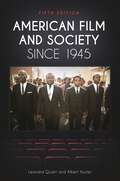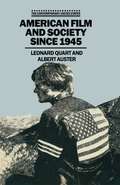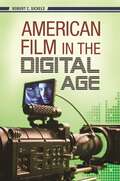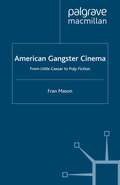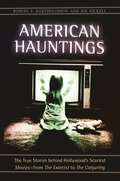- Table View
- List View
American Eccentric Cinema
by Kim WilkinsSince the late 1990s a new language has emerged in film scholarship and criticism in response to the popularity of American directors such as Wes Anderson, Charlie Kaufman, and David O. Russell. Increasingly, adjectives like 'quirky', 'cute', and 'smart' are used to describe these American films, with a focus on their ironic (and sometimes deliberately comical) stories, character situations and tones. Kim Wilkins argues that, beyond the seemingly superficial descriptions, 'American eccentric cinema' presents a formal and thematic eccentricity that is distinct to the American context. She distinguishes these films from mainstream Hollywood cinema as they exhibit irregularities in characterization, tone, and setting, and deviate from established generic conventions. Each chapter builds a case for this position through detailed film analyses and comparisons to earlier American traditions, such as the New Hollywood cinema of the 1960s and 1970s. American Eccentric Cinema promises to challenge the notion of irony in American contemporary cinema, and questions the relationship of irony to a complex national and individual identity.
American Film and Society since 1945
by Leonard Quart Albert AusterFrom Steven Spielberg's Lincoln to Clint Eastwood's American Sniper, this fifth edition of this classic film study text adds even more recent films and examines how these movies depict and represent the feelings and values of American society.One of the few authoritative books about American film and society, American Film and Society since 1945 combines accessible, fun-to-read text with a detailed, insightful, and scholarly political and social analysis that thoroughly explores the relationship of American film to society and provides essential historical context. The historical overview provides a "capsule analysis" of both American and Hollywood history for the most recent decade as well as past eras, in which topics like American realism; Vietnam, counterculture revolutions, and 1960s films; and Hollywood depictions of big business like Wall Street are covered. Readers will better understand the explicit and hidden meanings of films and appreciate the effects of the passion and personal engagement that viewers experience with films. This new edition prominently features a new chapter on American and Hollywood history from 2010 to 2017, giving readers an expanded examination of a breadth of culturally and socially important modern films that serves student research or pleasure reading. The coauthors have also included additional analysis of classic films such as To Kill a Mockingbird (1962) and A Face in the Crowd (1957).
American Film and Society since 1945
by Leonard Quart Albert AusterFrom Steven Spielberg's Lincoln to Clint Eastwood's American Sniper, this fifth edition of this classic film study text adds even more recent films and examines how these movies depict and represent the feelings and values of American society.One of the few authoritative books about American film and society, American Film and Society since 1945 combines accessible, fun-to-read text with a detailed, insightful, and scholarly political and social analysis that thoroughly explores the relationship of American film to society and provides essential historical context. The historical overview provides a "capsule analysis" of both American and Hollywood history for the most recent decade as well as past eras, in which topics like American realism; Vietnam, counterculture revolutions, and 1960s films; and Hollywood depictions of big business like Wall Street are covered. Readers will better understand the explicit and hidden meanings of films and appreciate the effects of the passion and personal engagement that viewers experience with films. This new edition prominently features a new chapter on American and Hollywood history from 2010 to 2017, giving readers an expanded examination of a breadth of culturally and socially important modern films that serves student research or pleasure reading. The coauthors have also included additional analysis of classic films such as To Kill a Mockingbird (1962) and A Face in the Crowd (1957).
American Film History: Selected Readings, 1960 to the Present
by Cynthia Lucia Roy Grundmann Art SimonFrom the American underground film to the blockbuster superhero, this authoritative collection of introductory and specialized readings explores the core issues and developments in American cinematic history during the second half of the twentieth-century through the present day. Considers essential subjects that have shaped the American film industry—from the impact of television and CGI to the rise of independent and underground film; from the impact of the civil rights, feminist and LGBT movements to that of 9/11. Features a student-friendly structure dividing coverage into the periods 1960-1975, 1976-1990, and 1991 to the present day, each of which opens with an historical overview Brings together a rich and varied selection of contributions by established film scholars, combining broad historical, social, and political contexts with detailed analysis of individual films, including Midnight Cowboy, Nashville, Cat Ballou, Chicago, Back to the Future, Killer of Sheep, Daughters of the Dust, Nothing But a Man, Ali, Easy Rider, The Conversation, The Texas Chain Saw Massacre, Longtime Companion, The Matrix, The War Tapes, the Batman films, and selected avant-garde and documentary films, among many others. Additional online resources, such as sample syllabi, which include suggested readings and filmographies, for both general and specialized courses, will be available online. May be used alongside American Film History: Selected Readings, Origins to 1960 to provide an authoritative study of American cinema from its earliest days through the new millennium
American Film History: Selected Readings, Origins to 1960
by Cynthia Lucia Roy Grundmann Art SimonThis authoritative collection of introductory and specialized readings explores the rich and innovative history of this period in American cinema. Spanning an essential range of subjects from the early 1900s Nickelodeon to the decline of the studio system in the 1960s, it combines a broad historical context with careful readings of individual films. Charts the rise of film in early twentieth-century America from its origins to 1960, exploring mainstream trends and developments, along with topics often relegated to the margins of standard film histories Covers diverse issues ranging from silent film and its iconic figures such as Charlie Chaplin, to the coming of sound and the rise of film genres, studio moguls, and, later, the Production Code and Cold War Blacklist Designed with both students and scholars in mind: each section opens with an historical overview and includes chapters that provide close, careful readings of individual films clustered around specific topics Accessibly structured by historical period, offering valuable cultural, social, and political contexts Contains careful, close analysis of key filmmakers and films from the era including D.W. Griffith, Charles Chaplin, Buster Keaton, Erich von Stroheim, Cecil B. DeMille, Don Juan, The Jazz Singer, I Am a Fugitive from a Chain Gang, Scarface, Red Dust, Glorifying the American Girl, Meet Me in St. Louis, Citizen Kane, Bambi, Frank Capra’s Why We Fight series, The Strange Love of Martha Ivers, Rebel Without a Cause, Force of Evil, and selected American avant-garde and underground films, among many others. Additional online resources such as sample syllabi, which include suggested readings and filmographies for both general specialized courses, will be available online. May be used alongside American Film History: Selected Readings, 1960 to the Present, to provide an authoritative study of American cinema through the new millennium
American Film History: Selected Readings, 1960 to the Present
by Cynthia Lucia Roy Grundmann Art SimonFrom the American underground film to the blockbuster superhero, this authoritative collection of introductory and specialized readings explores the core issues and developments in American cinematic history during the second half of the twentieth-century through the present day. Considers essential subjects that have shaped the American film industry—from the impact of television and CGI to the rise of independent and underground film; from the impact of the civil rights, feminist and LGBT movements to that of 9/11. Features a student-friendly structure dividing coverage into the periods 1960-1975, 1976-1990, and 1991 to the present day, each of which opens with an historical overview Brings together a rich and varied selection of contributions by established film scholars, combining broad historical, social, and political contexts with detailed analysis of individual films, including Midnight Cowboy, Nashville, Cat Ballou, Chicago, Back to the Future, Killer of Sheep, Daughters of the Dust, Nothing But a Man, Ali, Easy Rider, The Conversation, The Texas Chain Saw Massacre, Longtime Companion, The Matrix, The War Tapes, the Batman films, and selected avant-garde and documentary films, among many others. Additional online resources, such as sample syllabi, which include suggested readings and filmographies, for both general and specialized courses, will be available online. May be used alongside American Film History: Selected Readings, Origins to 1960 to provide an authoritative study of American cinema from its earliest days through the new millennium
American Film History: Selected Readings, Origins to 1960
by Cynthia Lucia Roy Grundmann Art SimonThis authoritative collection of introductory and specialized readings explores the rich and innovative history of this period in American cinema. Spanning an essential range of subjects from the early 1900s Nickelodeon to the decline of the studio system in the 1960s, it combines a broad historical context with careful readings of individual films. Charts the rise of film in early twentieth-century America from its origins to 1960, exploring mainstream trends and developments, along with topics often relegated to the margins of standard film histories Covers diverse issues ranging from silent film and its iconic figures such as Charlie Chaplin, to the coming of sound and the rise of film genres, studio moguls, and, later, the Production Code and Cold War Blacklist Designed with both students and scholars in mind: each section opens with an historical overview and includes chapters that provide close, careful readings of individual films clustered around specific topics Accessibly structured by historical period, offering valuable cultural, social, and political contexts Contains careful, close analysis of key filmmakers and films from the era including D.W. Griffith, Charles Chaplin, Buster Keaton, Erich von Stroheim, Cecil B. DeMille, Don Juan, The Jazz Singer, I Am a Fugitive from a Chain Gang, Scarface, Red Dust, Glorifying the American Girl, Meet Me in St. Louis, Citizen Kane, Bambi, Frank Capra’s Why We Fight series, The Strange Love of Martha Ivers, Rebel Without a Cause, Force of Evil, and selected American avant-garde and underground films, among many others. Additional online resources such as sample syllabi, which include suggested readings and filmographies for both general specialized courses, will be available online. May be used alongside American Film History: Selected Readings, 1960 to the Present, to provide an authoritative study of American cinema through the new millennium
American Film in the Digital Age (New Directions in Media)
by Robert C. SickelsThis eclectic, yet comprehensive analytical overview of the cataclysmic changes in the American film industry since 1990 shows how they have collectively resulted in a new era—The Digital Age.The American film industry has entered a new era. American Film in the Digital Age traces the industrial changes since 1990 that have brought us to this point, namely: the rise of media conglomerates, the proliferation of pornography through peripheral avenues of mainstream media, the role of star actors and directors in distributing and publicizing their own pet projects, the development of digital technology, and the death of truly independent films. Author Robert Sickels draws straight lines from the movies to music, DVDs, video games, fast food, digital-on-demand, and more, to demonstrate how all forms of media are merging into one. He explores the irony that the success of independent films essentially killed independent cinema, showing how it has become almost impossible to get a film released without the imprimatur of one of the big six media companies—Fox, Viacom, TimeWarner, Disney, General Electric, or CBS. In the end, using recent, popular films as examples, he explains not only how we got where we are, but where we're likely headed as well.
American Film in the Digital Age (New Directions in Media)
by Robert C. SickelsThis eclectic, yet comprehensive analytical overview of the cataclysmic changes in the American film industry since 1990 shows how they have collectively resulted in a new era—The Digital Age.The American film industry has entered a new era. American Film in the Digital Age traces the industrial changes since 1990 that have brought us to this point, namely: the rise of media conglomerates, the proliferation of pornography through peripheral avenues of mainstream media, the role of star actors and directors in distributing and publicizing their own pet projects, the development of digital technology, and the death of truly independent films. Author Robert Sickels draws straight lines from the movies to music, DVDs, video games, fast food, digital-on-demand, and more, to demonstrate how all forms of media are merging into one. He explores the irony that the success of independent films essentially killed independent cinema, showing how it has become almost impossible to get a film released without the imprimatur of one of the big six media companies—Fox, Viacom, TimeWarner, Disney, General Electric, or CBS. In the end, using recent, popular films as examples, he explains not only how we got where we are, but where we're likely headed as well.
American Film Satire in the 1990s: Hollywood Subversion
by J. NilssonThis study examines how a particular selection of films turned American cultural material of the 1990s into satirical experiences for viewers and finds that there are elements of resistance to norms and conventions in politics, to mainstream news channels and Hollywood, and to official American history already embedded in the culture.
American Gangster Cinema: From "Little Caesar" to "Pulp Fiction" (Crime Files)
by F. MasonMuch analysis of gangster movies has been based upon a study of the gangster as a malign figuration of the American Dream, originally set in the era of the Depression. This text extends previous analysis of the genre by examining the evolution of gangster movies from the 1930s to the contemporary period and by placing them in the context of cultural and cinematic issues such as masculinity, consumerism and technology. With a close examination of many films from Scarface and Public Enemy to Reservoir Dogs and Pulp Fiction , this book provides a fascinating insight into a topical and popular subject.
American Hauntings: The True Stories behind Hollywood's Scariest Movies—from The Exorcist to The Conjuring
by Robert E. Bartholomew Joe NickellThis work provides an accurate, in-depth examination and scientific evaluation of the most famous hauntings in American history as depicted in popular films and television programs.Neither a debunking book nor one written for the "true believer" in the paranormal, American Hauntings objectively scrutinizes the historic evidence behind such hugely popular films as The Exorcist, The Amityville Horror, An American Haunting, The Conjuring, and The Haunting in Connecticut to ascertain the accuracy of these entertainment depictions of "true life" hauntings. The authors then compare these popular culture accounts against the alleged real-life encounters and impartially weigh the evidence to assess whether each incident actually took place.Written by highly credentialed, recognized authorities on the paranormal and social psychology, this book contains meticulously documented, science-based information written for a broad audience, from middle and high school students and those taking introductory courses at a university level to general readers. There is no other work that provides as careful and unbiased an evaluation of the most famous hauntings in American history. The book also examines the reliability of popular television shows such as Unsolved Mysteries and Paranormal Witness.
American Hauntings: The True Stories behind Hollywood's Scariest Movies—from The Exorcist to The Conjuring
by Robert E. Bartholomew Joe NickellThis work provides an accurate, in-depth examination and scientific evaluation of the most famous hauntings in American history as depicted in popular films and television programs.Neither a debunking book nor one written for the "true believer" in the paranormal, American Hauntings objectively scrutinizes the historic evidence behind such hugely popular films as The Exorcist, The Amityville Horror, An American Haunting, The Conjuring, and The Haunting in Connecticut to ascertain the accuracy of these entertainment depictions of "true life" hauntings. The authors then compare these popular culture accounts against the alleged real-life encounters and impartially weigh the evidence to assess whether each incident actually took place.Written by highly credentialed, recognized authorities on the paranormal and social psychology, this book contains meticulously documented, science-based information written for a broad audience, from middle and high school students and those taking introductory courses at a university level to general readers. There is no other work that provides as careful and unbiased an evaluation of the most famous hauntings in American history. The book also examines the reliability of popular television shows such as Unsolved Mysteries and Paranormal Witness.
American History/American Film: Interpreting the Hollywood Image (Film Studies: Bloomsbury Academic Collections)
by John E. O'Connor Martin A. JacksonIn this pioneering work, sixteen historians analyse individual films for deeper insight into US institutions, values and lifestyles. Linking all of the essays is the belief that film holds much of value for the historian seeking to understand and interpret American history and culture. This title will be equally valuable for students and scholars in history using film for analysis as well as film students and scholars exploring the way social and historical circumstances are reflected and represented in film.
American History through Hollywood Film: From the Revolution to the 1960s
by Melvyn StokesAmerican History through Hollywood Film offers a new perspective on major issues in American history from the 1770s to the end of the twentieth century and explores how they have been represented in film. Melvyn Stokes examines how and why representation has changed over time, looking at the origins, underlying assumptions, production, and reception of an important cross-section of historical films. Chapters deal with key events in American history including the American Revolution, the Civil War and its legacy, the Great Depression, and the anti-communism of the Cold War era. Major themes such as ethnicity, slavery, Native Americans and Jewish immigrants are covered and a final chapter looks at the way the 1960s and 70s have been dealt with by Hollywood. This book is essential reading for anyone studying American history and the relationship between history and film.
American History through Hollywood Film: From the Revolution to the 1960s
by Melvyn StokesAmerican History through Hollywood Film offers a new perspective on major issues in American history from the 1770s to the end of the twentieth century and explores how they have been represented in film. Melvyn Stokes examines how and why representation has changed over time, looking at the origins, underlying assumptions, production, and reception of an important cross-section of historical films. Chapters deal with key events in American history including the American Revolution, the Civil War and its legacy, the Great Depression, and the anti-communism of the Cold War era. Major themes such as ethnicity, slavery, Native Americans and Jewish immigrants are covered and a final chapter looks at the way the 1960s and 70s have been dealt with by Hollywood. This book is essential reading for anyone studying American history and the relationship between history and film.
American Horror Fiction and Class: From Poe to Twilight (Palgrave Gothic)
by David SimmonsIn this book, Simmons argues that class, as much as race and gender, played a significant role in the development of Gothic and Horror fiction in a national context. From the classic texts of Edgar Allen Poe and Nathaniel Hawthorne right through to contemporary examples, such as the novels of Stephen King and Stephenie Meyer’s Twilight Series, class remains an ever present though understudied element. This study will appeal to scholars of American Studies, English literature, Media and Cultural Studies interested in class representations in the horror genre from the nineteenth century to the present day.
American Idol: The Untold Story
by Richard RushfieldThe currency is fame, and it's bigger than money, more desired than power. Each season American Idol delivers on a promise whose epic scope is unparalleled in the annals of competition: to take an unknown dreamer from the middle of America and turn him or her into a genuine star. It has become not only the biggest show on television, but the biggest force in all of entertainment; its alumni dominate the recording charts and Broadway, win Academy Awards, and sweep up Grammys. In fact, American Idol has reshaped the very idea of celebrity. But it didn't start out that way. When the little singing contest debuted as a summer replacement on the U.S. airwaves, it was packed between reruns and low-cost filler. The promise that it would find America's next pop star produced a hearty round of guffaws from the country's media critics. Now, some ten years and millions of records later, no one is laughing. American Idol: The Untold Story chronicles the triumphs and travails, the harrowing backstage drama and the nail-biting onstage battles that built this revolutionary show. In this revealing book, veteran journalist Richard Rushfield goes deeper inside the circus than any reporter ever has. Candid interviews with Idol alumni, including Simon Fuller and Simon Cowell, shed new light on the show that changed the entertainment industry. And because Rushfield had full access to the people who created the show, starred in it, and kept it atop the pop culture pyramid, this book is the first to take Americans behind the curtain and tell what has really been happening on the world's most watched and speculated-about stage.
American Idol After Iraq: Competing for Hearts and Minds in the Global Media Age
by Nathan Gardels Mike MedavoyThis dazzling little book explores the role of US media in foreign policy, not only at the present moment, but with an eye to the future. Written by a veteran Hollywood film executive and an internationally known columnist in foreign affairs Explains how American movies, TV shows, and pop music provide the images of America to the rest of the world, and the rest of the world to Americans Includes discussions of the cartoons of the Prophet Mohammed Danish daily newspapers, Tibetan monks censored out of Chinese TV news reports only to show up on You Tube, and the Vatican's assault on the Da Vinci Code movie Argues that Hollywood is a key player in the 'deep coalition' required to support a 'smart power' foreign policy and build a global cultural infrastructure that will make the world safe for interdependence
An American in Paris (BFI Film Classics)
by Sue HarrisAn American in Paris (1951) was a landmark film in the careers of Vincente Minnelli, Gene Kelly and Leslie Caron. A joyous celebration of George Gershwin's music, French art, the beauty of dance and the fabled City of Light, the film was heralded as a rare example of entertainment 'for mass and class alike'. Choreographed by Kelly at the height of his career, it gave new stature to the Hollywood musical, and showcased as never before the artistic ambition, technical skills, creative imagination and collaborative ethos of MGM's pioneering Arthur Freed Unit. Sue Harris draws on archival material to trace the film's development from conception to screen. Offering new insights into the design process in particular, she shows how An American in Paris established the cinematic template for a city with which Hollywood would become increasingly infatuated in the decades to follow.
An American in Paris (BFI Film Classics)
by Sue HarrisAn American in Paris (1951) was a landmark film in the careers of Vincente Minnelli, Gene Kelly and Leslie Caron. A joyous celebration of George Gershwin's music, French art, the beauty of dance and the fabled City of Light, the film was heralded as a rare example of entertainment 'for mass and class alike'. Choreographed by Kelly at the height of his career, it gave new stature to the Hollywood musical, and showcased as never before the artistic ambition, technical skills, creative imagination and collaborative ethos of MGM's pioneering Arthur Freed Unit. Sue Harris draws on archival material to trace the film's development from conception to screen. Offering new insights into the design process in particular, she shows how An American in Paris established the cinematic template for a city with which Hollywood would become increasingly infatuated in the decades to follow.
American Independent Cinema
by Geoff KingThe independent sector has produced many of the most distinctive films to have appeared in the US in recent decades. From 'Sex, Lies and Videotape' in the 1980s to 'The Blair Witch Project' and New Queer Cinema in the 1990s and the ultra-low budget digital video features of the 2000s, indie films have thrived, creating a body of work that stands out from the dominant Hollywood mainstream. But what exactly is 'independent' cinema? This, the first book to examine the question in detail, argues that independence can be defined partly in industry terms but also according to formal and aesthetic strategies and by distinctive attitudes towards social and political issues, suggesting that independence is a dynamic rather than a fixed quality. Chapters focus on distribution and relationships with Hollywood studios; narrative ('Clerks' and 'Slacker' to 'Pulp Fiction', 'Magnolia' and 'Memento') and other formal dimensions (from 'Blair Witch's' 'authenticity' to expressive and stylized camerawork and editing in work from Harmony Korine to the Coen brothers); approaches to genre and alternative socio-political visions.
American Independent Cinema: Indie, Indiewood And Beyond
by Geoff KingFrom sex, lies and videotape in the 1980s to The Blair Witch Project and New Queer Cinema in the 1990s and the ultra-low budget digital video features of the 2000s, indie films have thrived and stand out from the dominant Hollywood mainstream. But what exactly is 'independent' cinema? This, the ideal textbook and general read on indie cinema, shows that independence can be defined partly in industry terms but also according to formal and aesthetic strategies and by distinctive attitudes towards social and political issues, suggesting that independence is a dynamic rather than a fixed quality. Chapters focus on distribution and relationships with Hollywood studios; narrative (Clerks and Slacker to Pulp Fiction, Magnolia and Memento) and other formal dimensions (from Blair Witch's 'authenticity' to expressive and stylized camerawork and editing in work from Harmony Korine to the Coen brothers); approaches to genre and alternative socio-political visions.
American Independent Cinema: Rites of Passage and the Crisis Image (Edinburgh Studies in Film and Intermediality (PDF))
by Anna Backman RogersAnna Backman Rogers argues that American independent cinema is a cinema not merely in crisis, but also of crisis. As a cinema which often explores the rite of passage by explicitly drawing on American cinematic heritage, from the teen movie to the western, American independent films deal in images of crisis, transition and metamorphosis, offering a subversive engagement with more traditional modes of representation.  Examining films by Gus Van Sant, Jim Jarmusch and Sofia Coppola to highlight their use of cinematic time as a mode of philosophical thought, this book brings new and exciting perspectives to American independent cinema.

